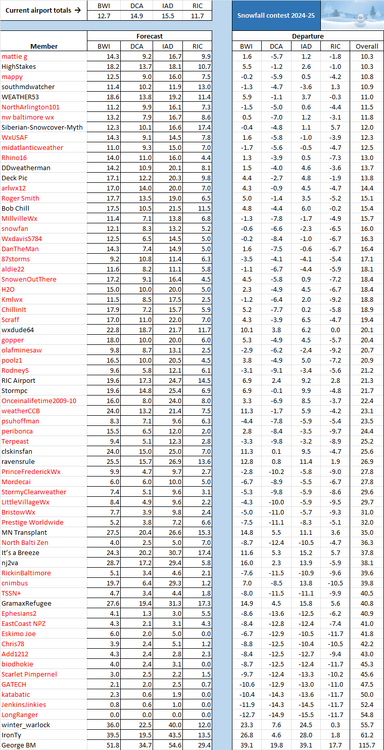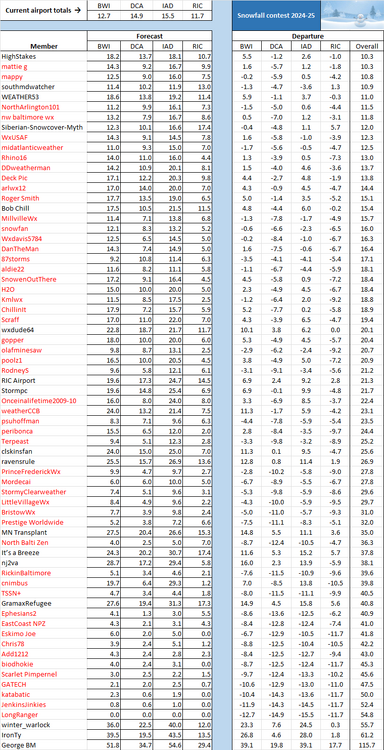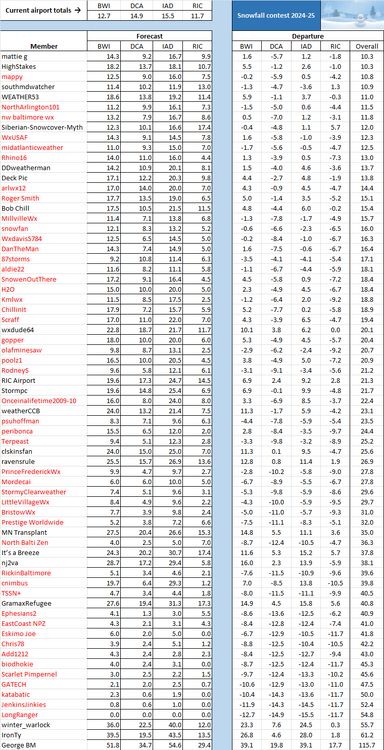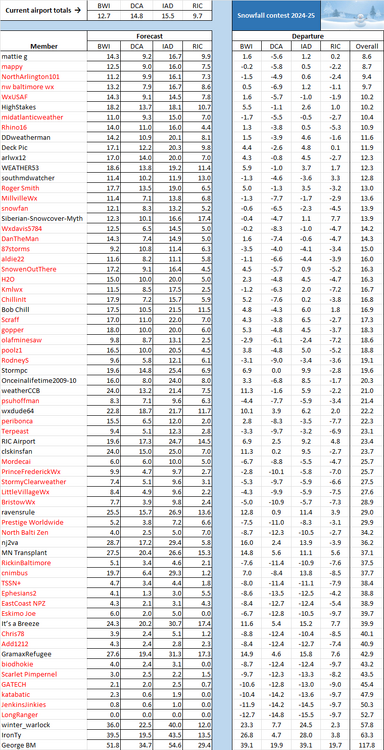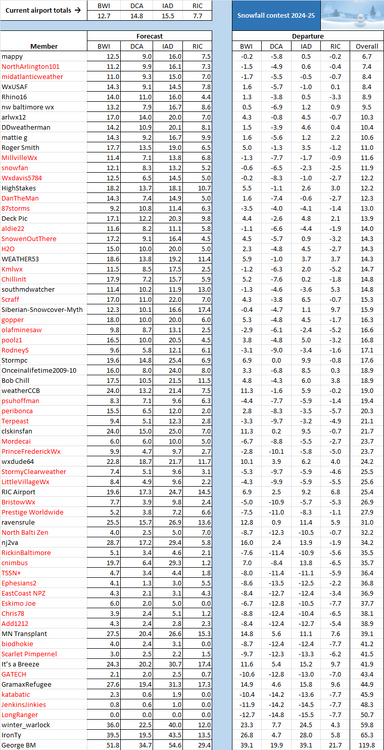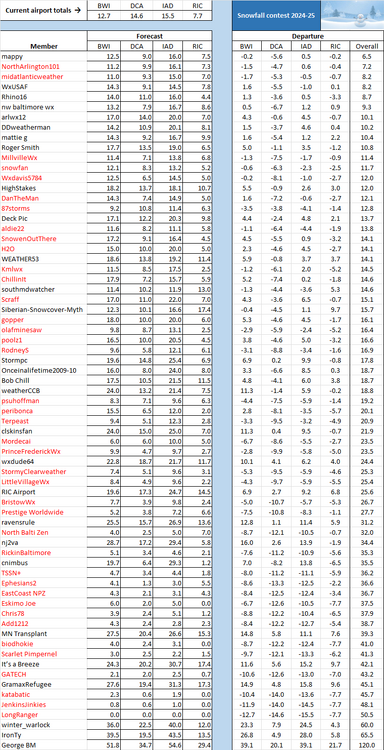
RodneyS
Members-
Posts
1,345 -
Joined
-
Last visited
Content Type
Profiles
Blogs
Forums
American Weather
Media Demo
Store
Gallery
Everything posted by RodneyS
-
June 2025 was a down and up month at DCA, with a late heat wave more than offsetting the early cool temperatures. The net result was an average June 2025 temperature of 76.9 degrees, which was 0.6 above the 1991-2020 normal and tied for the 19th warmest in DC history. That resulted in a January-June 2025 DCA temperature of 55.9 degrees, behind last year's first half (57.6) and even further behind the record high first half established in 2012 (58.0). Precipitation was again well above average at 5.48 inches, 28th wettest June in DC history.
-
FYI, DCA made it to 92 today to put June 12th into the record book as officially the first 90+ day of 2025 in DC. IAD fell just short, peaking at 89.
-
At DCA today the high temperature failed to reach 90 degrees, which has been true of every day this year. Since 2003, when DCA recorded its first 90 degree or greater reading of the year on June 24th, the first 90+ reading has occurred in a range from April 6th to June 11th. Thus, this year's first 90+ reading (which may occur tomorrow) will be the latest in (at least) 22 years. FYI, the latest day of the year in official DC weather history for the first 90+ reading is July 12th, which occurred in 1979. That year, like 2003, there were a total of twenty 90+ days. The (two) years with the fewest number of 90+ days in DC history occurred much further back -- in 1886 and 1905, with seven each. In 1886, the first 90+ day was July 7th and the last was September 28th; in 1905, the first 90+ day was June 6th and the last was August 13th. At the other end of the spectrum, the (two) years with the greatest number of 90+ days in DC history occurred in 1980 and 2010, with sixty-seven each. In 1980, the first 90+ day was May 13th and the last was September 23rd; in 2010, the first 90+ day was April 6th and the last was September 25th.
-
May 2025 was an up and down month at DCA, with May 1-19 recording a relatively warm 69.7 degrees, but May 20-31 recording a decidedly cool 62.6 degrees. The net result was an average May 2025 temperature of 67.0 degrees, which was 0.2 below the 1991-2020 normal and only the 46th warmest in DC history. That resulted in a January-May 2025 DCA temperature of 51.7 degrees, well behind last year's first five months (53.2) and even further behind the record high first five months established in 2012 (54.4). The bigger story of May 2025 at DCA was the drought-busting precipitation of 7.73 inches, 9th highest May total in DC history and the highest monthly total at DCA since August 2021 (9.07).
-
April 2025 continued the warmth, coming in as the 6th warmest April in DC history, with an average temperature of 61.7 at DCA, exceeded only by 2017 (63.8), 2019 (62.4), 1981 and 2023 (62.1), and 1994 (62.0). During last year's recordbreaking warm year in DC, April averaged 60.5 at DCA. However, January-April 2025 at DCA was below last year, at 47.8 vs 49.1. The warmest January-April in DC history was 50.1 at DCA in 2012.
-
A far more exciting contest this season than the last two, with six lead changes and anticipation in mid-February of a blockbuster storm at the four airports on February 19-20. Unfortunately for snow lovers, the Euro model's Valentine Day's tease of 16.1 inches in DC on those two days was correct only after the decimal point -- the other 16 inches went south. Still, that storm played a crucial role in determining this season's winner. To recap this season's contest, @LongRanger's zero across the board forecast maintained the lead until some early January snow propelled @RickinBaltimore into a brief lead on the 6th of that month. It appeared that @psuhoffmanhad wrested the lead away on the 7th, only to find that downward revisions to RIC's total had instead put @StormyClearweather in front. However, additional snow did eventually put @psuhoffmanin control on January 11th, and he held onto the lead for more than a month. A February 11-12 storm put @mappyinto the lead on the 12th. It was about that time that all of us began hearing about a potentially historic storm in the Mid-Atlantic about a week down the road. But by the time Valentine's Day weekend concluded on February 16th, it was clear that would not happen at BWI, DCA, or IAD, although there was still a possibility at RIC. Even when it became certain on February 18th that the major snow would fall mainly in southern Virginia, there was still a realistic chance of at least 4.3 inches at RIC, which would have put @southmdwatcherin the lead on a tiebreaker. After an early report of 2 inches there on February 19th put @mattie gin the lead, an additional 2 inches at RIC gave the lead to @HighStakes on a tiebreaker with @mattie gat the end of the day. The question then became, would February 20th produce at least another 0.3 inches at RIC? In a word, no, as only a trace fell there on that day. The final question was, would the rest of the 2024-25 winter season produce at least a little more snow? The answer was a ringing no, as the Mid Atlantic turned into Florida North in March. And so, the time has come to award the 2024-25 Championship Trophy to @HighStakeson a tiebreaker over @mattie g. This is only the second tiebreaker in the history of this 11-year-old contest, with the previous one having occurred six years ago, when @olafminesaw edged out @Stormpc. See you in November!
-
March 2025 was the 4th warmest March in DC history, with an average temperature of 54.3 at DCA, exceeded only by 2012 (56.8), 1945 (56.2), and 1921 (55.5). During last year's recordbreaking warm year in DC, March averaged 51.9 at DCA. However, January-March 2025 at DCA was well below last year, at 43.2 vs 45.4. The warmest January-March in DC history was 47.3 at DCA in 2012.
-
I'm still going to wait until next week to officially close out the contest, but it would take a minor miracle for more snow to fall at any of the four airports, and so your 5th place finish looks assured. You did better at SBY than our top two finishers, and I'm sure that co-leader @mattie gis wishing he had gone with your forecast of 13.8 inches there, instead of his forecast of 8.6 (and our presumptive winner @HighStakesforecast of 10.8). However@IronTyhad his 15 minutes of fame with a nearly dead-on forecast at SBY of 21.5 inches, compared with the actual of 21.3. FYI, @DanTheManhad the best forecast at LYH of 11.0 inches, compared with an actual of 12.4.
-
The 2024-25 astronomical and composite winters were each much cooler than last season at DCA. The former averaged 41.1 degrees, tied for the 29th warmest in DC history and down 4.1 from last year; while the latter averaged 41.3 degrees, tied for the 27th warmest in DC history and down 3.8 from last year.
-
Are you saying that because you can recall April 1938, Roger? Actually, there was only a trace of snow in DC then, after an average March temperature of 49.8 degrees. However, I can recall a stunning Mid-Atlantic turnaround that occurred much more recently. March 1990 at DCA averaged 50.2 degrees, and featured these maximums during March 12-16: 89/87/86/81/81. The Mid-Atlantic winter was over, right? Not so fast. During March 20-April 7, 1990, BWI received 2.8 inches of snow, DCA received 2.6 inches, RIC received 0.2 inches, and IAD received -- would you believe -- 10.4 inches? Moreover, each airport received measurable snow on either April 6th or 7th, with IAD checking in at 2.7 inches on the 6th and 1.1 inches on the 7th.
-
The Capital Weather Gang has declared winter over in DC, and they have a good track record of not doing so until the last measurable snow has fallen in these parts; see https://www.washingtonpost.com/weather/2025/03/10/winter-over-spring-starts-dc. While I will not award the 2024-25 trophy until at least April 1st, things are looking good for @HighStakes. Even if a little more snow falls at any of the four airports, it will likely be at BWI or IAD, where he can still improve. @southmdwatcherhas some hope, but only if RIC can eke out at least 0.3 inches, with little or no snow at the other three airports. Under a 0.3 at RIC and zero at the other three airports scenario, he, HighStakes and @mattie g would each finish with a departure of 10.6, and he would win a three-way tiebreaker. However, the far more likely scenario is a two-way tie between HighStakes and mattie g, with HighStakes winning the tiebreaker with his closer forecast at SBY.
-
February 2025 at DCA ended warm, bringing the average temperature to 41.0 degrees -- tied for the 34th warmest February in DC history. That brought the 2024-25 meteorological winter (December, January, and February) average to 39.0 degrees -- tied for the 43rd warmest in DC history. Nonetheless, the 2024-25 DCA meteorological winter was the coldest in 10 years -- surpassing every winter for cold since the 2014-15 winter averaged 36.7 degrees. The historical average for all 154 DC winters since recordkeeping began in 1871-72 is 37.1 degrees.
-
FYI, each of the four airports recorded only a trace of snow today. However, I am updating the table to show that -- barring corrections to the snow totals -- two more contestants have been eliminated from contention, to bring that total to 50 (in red), leaving only 19 who still have a chance to win. Most stunningly, I have determined that co-leader @mattie g has bitten the dust. Why is that? Because while he could still finish in a first-place tie with @HighStakes, he would lose the tiebreaker based on his forecast of 8.6 inches of snow at Salisbury (SBY) vs High Stake's forecast of 10.8 inches there. Because SBY has already recorded 17.8 inches this season, mattie g is history -- just as the other 49 of us are.
-
-
We have a new leader, as RIC has already recorded 2.0 inches today. That puts @mattie gin first place, with @HighStakesa big threat to move into a tie before day's end and @southmdwatcherlurking if RIC records several more inches.
-
Yes, and this season may make it 15 times. By the way, the largest amount by which DCA snow exceeded BWI snow was 5.5 inches in 1979-80 -- 20.1 inches at DCA, 14.6 at BWI. On the other hand, the largest amount by which BWI snow exceeded DCA snow was 20.9 inches in 2009-10 -- 77.0 inches at BWI and 56.1 inches at DCA. Both totals were record-breakers for any year in Baltimore and DC dating back to the 1880s, and the BWI total even exceeded IAD's record-breaking total of 73.2 inches that memorable snow season 15 years ago.
-
DCA became the official DC weather location in July 1945, and BWI began operations in June 1950. Thus, winter season comparisons between the two airports begin in 1950-51, and so there are now 74 winter season comparisons in the books. During those 74 seasons, DCA has averaged 15.5 inches of snow, and BWI has averaged 19.8 inches, with BWI snow exceeding DCA snow 58 times, DCA snow exceeding BWI snow 14 times, and two seasons ending in a tie.
-
Thanks. What I was going by was Wednesday's daily report for DCA issued at 12:35 AM this morning, which may be found at "Observed Weather" "Daily Climate Report" for "Washington-National" at https://www.weather.gov/wrh/Climate?wfo=lwx. The newest version is currently for Thursday, but you can find the 12:35 AM version for Wednesday by clicking "2" at the top (in blue). It's head-scratching how these contradictions occur, but you are correct that the snow total for yesterday is now back up to 0.5 inches. The below table reflects that change for DCA:
-
The DCA measuring gurus have helped you and a number of other folks by revising downward yesterday's snow total there from 0.5 to 0.3 inches. It would be interesting to know how these revisions come about -- perhaps some of the gurus don't realize that you are not supposed to take snow away from the measuring location to make a snowman? In any event, here is the slightly revised leaderboard, subject to further revisions without warning. P.S. I have listed in red all of the unfortunates who have been eliminated . . . whoops, that includes me.
-
Don't shortchange yourself, @snowfan -- you are currently 12th. Unfortunately, because you have all negative departures, your chance of winning are the same as mine and 38 others -- zero.





